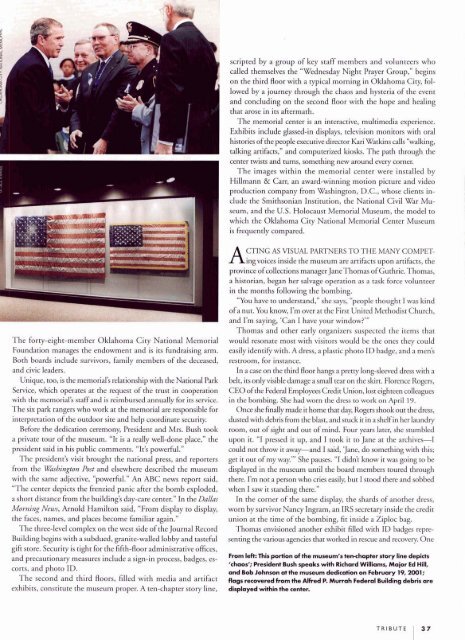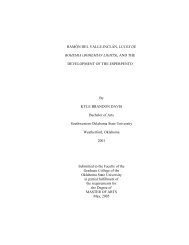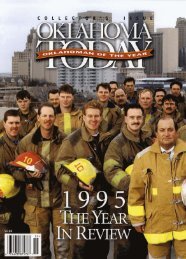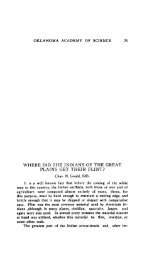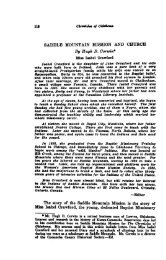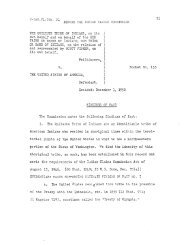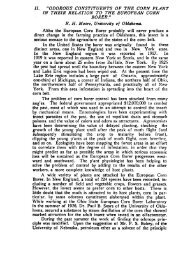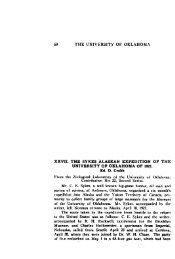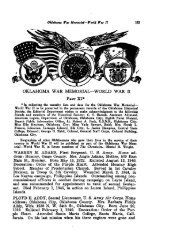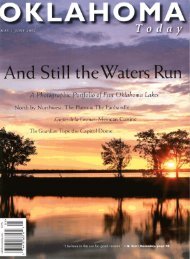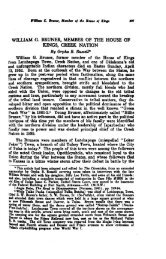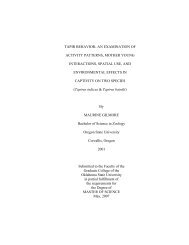Oklahoma Today July-August 2003 Volume 53 No. 4
Oklahoma Today July-August 2003 Volume 53 No. 4
Oklahoma Today July-August 2003 Volume 53 No. 4
You also want an ePaper? Increase the reach of your titles
YUMPU automatically turns print PDFs into web optimized ePapers that Google loves.
The forty-eight-member <strong>Oklahoma</strong> City National Memorial<br />
Foundation manages the endowment and is its fundraising arm.<br />
Both boards include survivors, family members of the deceased,<br />
and civic leaders.<br />
Unique, too, is the memorial's relationship with the National Park<br />
Service, which operates at the request of the trust in cooperation<br />
with the memorial's staffand is reimbursed annually for its service.<br />
The six park rangers who work at the memorial are responsible for<br />
interpretation of the outdoor site and help coordinate security.<br />
Before the dedication ceremony, President and Mrs. Bush took<br />
a private tour of the museum. "It is a really well-done place," the<br />
president said in his public comments. "It's powerful."<br />
The president's visit brought the national press, and reporters<br />
from the Washington Post and elsewhere described the museum<br />
with the same adjective, "powerful." An ABC news report said,<br />
"The center depicts the frenzied panic after the bomb exploded,<br />
a short distance from the building's day-care center." In the Dallas<br />
Morning Nezus, Arnold Hamilton said, "From display to display,<br />
the faces, names, and places become familiar again."<br />
The three-level complex on the west side of the Journal Record<br />
Building begins with a subdued, granite-walled lobby and tasteful<br />
gift store. Security is tight for the fifth-floor administrative offices,<br />
and precautionary measures include a sign-in process, badges, escorts,<br />
and photo ID.<br />
The second and third floors, filled with media and artifact<br />
exhibits, constitute the museum proper. A ten-chapter story line,<br />
scripted by a group of key staff members and volunteers who<br />
called themselves the "Wednesday Night Prayer Group," begins<br />
on the third floor with a typical morning in <strong>Oklahoma</strong> City, followed<br />
by a journey through the chaos and hysteria of the event<br />
and concluding on the second floor with the hope and healing<br />
that arose in its aftermath.<br />
The memorial center is an interactive, multimedia experience.<br />
Exhibits include glassed-in displays, television monitors with oral<br />
histories of the people executive director Kari Watkins calls "walking,<br />
talking artifacts," and computerized kiosks. The path through the<br />
center twists and turns,something new around every corner.<br />
The images within the memorial center were installed by<br />
Hillmann & Carr, an award-winning motion picture and video<br />
production company from Washington, D.C., whose clients include<br />
the Smithsonian Institution, the National Civil War Museum,<br />
and the U.S.Holocaust Memorial Museum, the model to<br />
which the <strong>Oklahoma</strong> City National Memorial Center Museum<br />
is frequently compared.<br />
ACTING AS VISUAL PARTNERS TO THE MANY COMPETingvoices<br />
inside the museum are artifacts upon artifacts, the<br />
province of collections manager Jane Thomas of Guthrie. Thomas,<br />
a historian, began her salvage operation as a task force volunteer<br />
in the months following the bombing.<br />
"You have to understand," she says, "people thought I was kind<br />
of a nut. You know, I'm over at the First United Methodist Church,<br />
and I'm saying,<br />
- - 'Can I have your window?"'<br />
Thomas and other early organizers suspected the items that<br />
would resonate most with visitors would be the ones they could<br />
easily identlfy with. A dress, a plastic photo ID badge, and a men's<br />
restroom, for instance.<br />
In a case on the third floor hangs a pretty long-sleeved dress with a<br />
belt, its only visible damage a small tear on the skirt. Florence Rogers,<br />
CEO of the Federal Employees Credit Union, lost eighteen colleagues<br />
in the bombing. She had worn the dress to work on April 19.<br />
Once she finally made it home that day, Rogers shook out the dress,<br />
dusted with debris fiom the blast, and stuck it in a shelf in her laundry<br />
room, out of sight and out of mind. Four years later, she stumbled<br />
upon it. "I pressed it up, and I took it to Jane at the archives-I<br />
could not throw it awayand I said, 'Jane, do something with this;<br />
get it out of my way."' She pauses. "I didn't know it was going to be<br />
displayed in the museum until the board members toured through<br />
there. I'm not a person who cries easily, but I stood there and sobbed<br />
when I saw it standing there."<br />
In the corner of the same display, the shards of another dress,<br />
worn by survivor Nancy Ingram, an IRS secretary inside the credit<br />
union at the time of the bombing, fit inside a Ziploc bag.<br />
Thomas envisioned another exhibit filled with ID badges - repre-<br />
-<br />
senting the various agencies that worked in rescue and recovery. One<br />
From left: This portion of the museum's tewchapter story line depicts<br />
'chaos'; President Bush speakswith RichardWilliams, Major Ed Hill,<br />
and Bob Johnson at the museum dedication on February 19,2001;<br />
flags recovered from the Alfred P. Murrah Federal Building debris are<br />
displayed within the center.


